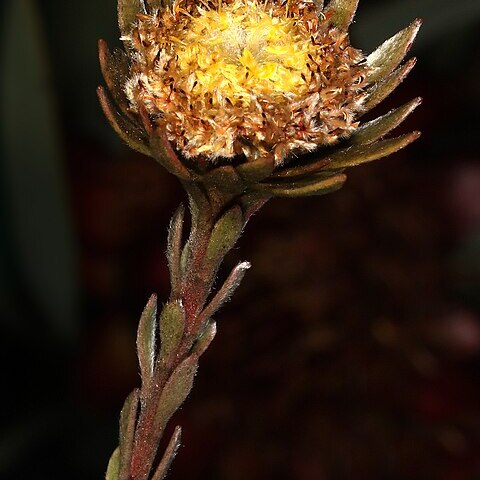Shrubs 30 cm to 2 m tall, decumbent or erect, with a silvery appearance, with many stems arising from near ground level. Branches slender, densely short sub-adpressed pubescent becoming glabrous and leafless after about two seasons, straight and erect or short and spreading. Leaves of male plants 9.5-15 mm long, 2.2-3.7 mm broad, of female plants 11.5-20 mm long, 2.5-5 m broad, in both sexes narrowly oblanceolate, apex sub-acute or occasionall obtuse with a small callus, narrowed to the base, densely adpressed-short-pubescent. Involucral leaves of male plants 14-43 mm long, 2.8-5 mm broad, of female plants 21-48 mm long, 3.5-7.5 mm broad, the larger, when found surround the uppermost heads, crowded, somewhat yellowish, not concealin the head, similar to the stem leaves. Male inflorescence 9-15 mm long, 15-2 mm diam., usually solitary, terminal, depressed-globose, giving off a stron sweet smell. Basal bracts 4-9 mm long, 3-7 mm broad, about 102 cm number lanceolate, acute or acuminate and glandular at the apex, ciliate, pubescen above. Floral bract 4.5-7 mm long, 1.5-0.5 mm broad, oblanceolate-obtuse an densely pubescent or linear being broadened, ciliate and long-pubescent abov and glabrous below. Floral bud 5-11 mm long, short-crisped-pubescent above surrounded below by a tuft of long hairs. Perianth tube connate with the style 5-8 mm long, glabrous and narrower below. Claw 1-3 mm long, recurved 180° short-pubescent. Limb 1.3-2.7 mm long, short-pubescent, linear. Anther 1-1. mm long, apex acute and brown. Pollen triangular in polar view with sides 35-38 µ long, polar depth 20-24µ. Stigma abortive 0.5-1.5 mm long, clavate, actin as a pollen presenter. Style 1-2.5 mm long, glabrous, narrower above Hypogynous scales absent. Nectar absent. Receptacle 4 mm long, 3 mm diam. depressed-globose. Female inflorescence often differing much in size on th same branch, 15-20 mm long, 12-18 mm diam., ovoid, villous with the floret clustered at the apex, giving off a strong sweet smell. Basal bracts 5-10 m long, 4-7 mm broad, about 102 cm number, similar to the male but the inner becoming broader and more pubescent, apex glandular. Floral bract 7-9 mm long, 6-6.5 mm broad, broadly lanceolate, acute, long-ciliate, densely silky pubescent. Floral bud 8-9 mm long, densely silky pubescent, linear, segments free except at the apex. Perianth segments free, 5-8 mm long, silky villous, the posterior segment clasping the style and the dorsal ridge of the ovary. Claw 1.5-3 mm long, recurved 180°, pubescent. Limb 1.5-2.5 mm long, linear, pubescent. Staminode 0.8-1.5 mm long, linear. Ovary 1.5-1.7 mm long, 1 mm broad, oblong, bilobed above, weakly short-pubescent, style inserted dorsally. Style 7-9.5 mm long, filiform, glabrous, thickened at the apex. Stigma 0.8-0.9 mm broad, terminal, cleft. Hypogynous scales absent or rudimentary, 0.5 mm long. Nectar absent. Receptacle 6-8 mm long, 4-5 mm diam., obconic-globose. Mature female head dehiscent, depressed-globose, up to 2 cm long, and 2.5 cm diam., with densely pubescent bracts, the outer glabrescent. Fruit a nut, 7-8.5 mm long, 4-4.5 mm broad, ventricose, perimeter ridged, dorsally double-ridged, smooth, shining, greyish.
More
Erect to spreading, resprouting, dioecious shrub to 2 m, branching at base. Leaves linear-oblanceolate, silvery adpressed-hairy, 9-15 mm long (male), 11-20 mm (female), involucral leaves twice as long, yellow. Male flower heads 15-20 mm diam., female 12-18 mm diam., sweetly scented.


